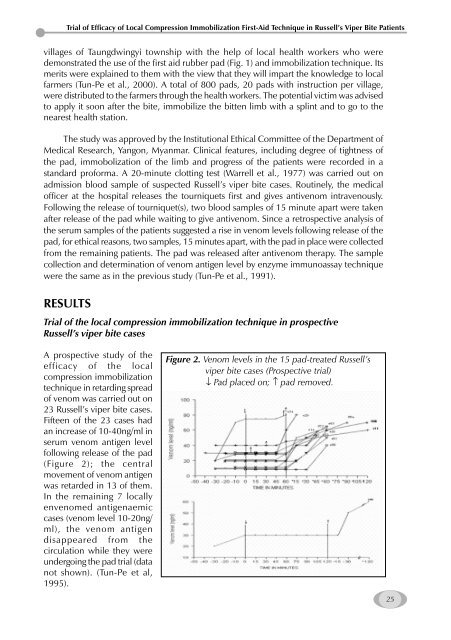Management of Snakebite and Research Management of Snakebite ...
Management of Snakebite and Research Management of Snakebite ...
Management of Snakebite and Research Management of Snakebite ...
You also want an ePaper? Increase the reach of your titles
YUMPU automatically turns print PDFs into web optimized ePapers that Google loves.
Trial <strong>of</strong> Efficacy <strong>of</strong> Local Compression Immobilization First-Aid Technique in Russell’s Viper Bite Patients<br />
villages <strong>of</strong> Taungdwingyi township with the help <strong>of</strong> local health workers who were<br />
demonstrated the use <strong>of</strong> the first aid rubber pad (Fig. 1) <strong>and</strong> immobilization technique. Its<br />
merits were explained to them with the view that they will impart the knowledge to local<br />
farmers (Tun-Pe et al., 2000). A total <strong>of</strong> 800 pads, 20 pads with instruction per village,<br />
were distributed to the farmers through the health workers. The potential victim was advised<br />
to apply it soon after the bite, immobilize the bitten limb with a splint <strong>and</strong> to go to the<br />
nearest health station.<br />
The study was approved by the Institutional Ethical Committee <strong>of</strong> the Department <strong>of</strong><br />
Medical <strong>Research</strong>, Yangon, Myanmar. Clinical features, including degree <strong>of</strong> tightness <strong>of</strong><br />
the pad, immobolization <strong>of</strong> the limb <strong>and</strong> progress <strong>of</strong> the patients were recorded in a<br />
st<strong>and</strong>ard pr<strong>of</strong>orma. A 20-minute clotting test (Warrell et al., 1977) was carried out on<br />
admission blood sample <strong>of</strong> suspected Russell’s viper bite cases. Routinely, the medical<br />
<strong>of</strong>ficer at the hospital releases the tourniquets first <strong>and</strong> gives antivenom intravenously.<br />
Following the release <strong>of</strong> tourniquet(s), two blood samples <strong>of</strong> 15 minute apart were taken<br />
after release <strong>of</strong> the pad while waiting to give antivenom. Since a retrospective analysis <strong>of</strong><br />
the serum samples <strong>of</strong> the patients suggested a rise in venom levels following release <strong>of</strong> the<br />
pad, for ethical reasons, two samples, 15 minutes apart, with the pad in place were collected<br />
from the remaining patients. The pad was released after antivenom therapy. The sample<br />
collection <strong>and</strong> determination <strong>of</strong> venom antigen level by enzyme immunoassay technique<br />
were the same as in the previous study (Tun-Pe et al., 1991).<br />
RESULTS<br />
Trial <strong>of</strong> the local compression immobilization technique in prospective<br />
Russell’s viper bite cases<br />
A prospective study <strong>of</strong> the<br />
efficacy <strong>of</strong> the local<br />
compression immobilization<br />
technique in retarding spread<br />
<strong>of</strong> venom was carried out on<br />
23 Russell’s viper bite cases.<br />
Fifteen <strong>of</strong> the 23 cases had<br />
an increase <strong>of</strong> 10-40ng/ml in<br />
serum venom antigen level<br />
following release <strong>of</strong> the pad<br />
(Figure 2); the central<br />
movement <strong>of</strong> venom antigen<br />
was retarded in 13 <strong>of</strong> them.<br />
In the remaining 7 locally<br />
envenomed antigenaemic<br />
cases (venom level 10-20ng/<br />
ml), the venom antigen<br />
disappeared from the<br />
circulation while they were<br />
undergoing the pad trial (data<br />
not shown). (Tun-Pe et al,<br />
1995).<br />
Figure 2. Venom levels in the 15 pad-treated Russell’s<br />
viper bite cases (Prospective trial)<br />
↓ Pad placed on; ↑ pad removed.<br />
25









